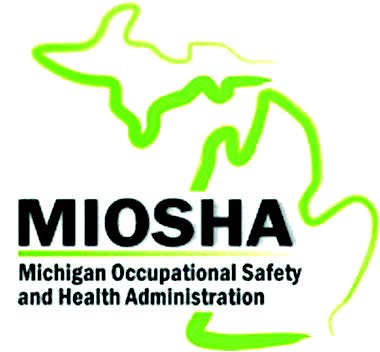By Chris Demeter, Senior Loss Control Consultant
This year marks my 16th year with MTMIC as a Senior Loss Control Consultant. My prior job was a Safety Director at a prototype stamping manufacturer in Livonia and our sister pattern shop company in St. Clair Shores. I was responsible for developing safety policy, employee safety training, monitoring all health and safety incidents, and ensuring the overall safety of the workplace of over 200-employees. Every year and a half or so, I would receive a visit from a MIOSHA Compliance officer. It was not because we had above average injuries; it was because we were in a targeted industry with historically high rate of occupational injuries and illnesses. Some of those targeted industries would include press shops, forgers, foundries, platers, heat treat, and fabrication shops just to name a few. Those industries are targeted because there are greater risk factors for injury then let’s say a grocery store. The company I worked for had power presses ranging from 50-ton to 1,400-ton and we had a Kirksite foundry, hence the frequent visits.
If you’ve never been through a MIOSHA compliance visit, lucky you. If you have, I feel your pain. Depending on the size of your company, the visit can last half a day and up to 3-days. With my background, I’m often asked what happens during a MIOSHA visit. A compliance officer arrives unannounced and asks for a management representative. If the company is a union shop, a designated union representative will be asked to participate. The compliance officer holds an opening conference to explain the purpose of the visit, the investigation format, and employer and employee rights and responsibilities. Employers are advised that employees are protected from discrimination for exercising a right provided by MIOSHA.
The compliance officer may review required MIOSHA documents such as the Injury/Illness log (Form-300) and required written programs or procedures that apply to the workplace such as Hazard Communication/Right to Know, Lockout/Tagout, Personnel Protective Equipment (PPE), and Respiratory Protection. They may also request proof of training and for all mentioned programs or procedures. Private interviews will be conducted with employees. The compliance officer will conduct a walk-around of the workplace. Exposure measurements will be taken if necessary. Conditions that could endanger the safety and health of employees will be identified and documented as they relate to violations of MIOSHA standards. The compliance officer will encourage dialogue and questions related to safety and health issues, and offer suggestions and explanations as to how hazards might be abated. The goal is to foster a mutual interest in eliminating or reducing workplace hazards. This includes recognizing good safety and health practices.
At the completion of the investigation, a closing conference is held to:
- Discuss proposed citations and/or any recommendations
- Establish time frame to correct any hazards
- Review MIOSHA’s posting requirements and settlement options
- Provide information
informationThe compliance officer compiles the findings from the investigation into a written report. The report includes any alleged violation(s) which could result in citations. MIOSHA citations may carry monetary penalties. Citation(s) include a description of the alleged violation(s) and the applicable rule(s). Conditions must be corrected on or before the date(s) shown on the citation(s). MIOSHA citations are classified according to the serious nature of an injury that might result if an incident were to occur.These classifications are:
Willful — A violation committed with an intentional disregard or plain indifference to the requirements of MIOSHA regulations or employee safety and health.
Serious — A hazard exists that has a likelihood of causing serious physical harm or death.
Repeat Serious — A violation of the same rule within three years (Construction) or five yearArtistic Industry).
Other-than-Serious — A hazard exists and could cause an injury, but most likely would not result in death or serious physical harm.
Serious violations must contain a monetary penalty, with the maximum penalty being $7,000. Any violation classified as Willful must have a minimum penalty of $5,000, with the maximum penalty being $70,000.
Employers may be eligible for Penalty Reduction Agreement (PRA) (formerly: Informal Settlement Agreement), depending on their efforts to comply with the MIOSH Act. Penalty adjustments are based on the seriousness of the violation, size of business, and past MIOSHA history. Citation(s) are sent by certified mail to the employer. The employer must post a copy of the citation(s) at or near the location where an alleged violation occurred. The citation(s) must be posted immediately upon receipt and remain posted until all items are corrected, or for three-working days, whichever is longer.
Employers must send documentation of abatement to MIOSHA for Willful, Serious, and Repeat violation(s). Examples of abatement documentation for these violation classifications include:
- A detailed description of how the violation was abated
- A work order, invoice, or photographs showing the corrective work
- Evidence that employees are no longer exposed to the hazard
- Employers must submit a signed document stating that Other-than-Serious violation(s) were corrected. The abatement documentation must be mailed to the issuing division indicating it is for abatement purposes.
If an item is indicated “ABATED” in the “Date by Which Violation Must Be Abated” line, no further action is needed to notify MIOSHA. An appeal or request for an extension of time only postpones the abatement period for the specific items which are appealed or requested for extension. If no appeal or extension is requested for a given citation item, the documentation of abatement must be mailed to the issuing division within three working days of the abatement time frame listed on the citation item. If an appeal or an extension of time is filed for a citation item, the abatement period for that item begins the date the settlement or decision pertaining to that item becomes a final order, or on the specific abatement date specified by the extension order. Documentation of abatement must be mailed within three-working days of when the abatement time frame elapses.
If a citation(s) is issued, an employer has the following options:
Request a Penalty Reduction Agreement (PRA):
- Obtain a significantly reduced penalty
- Expedite the correction of hazards
- Apply for a PRA online at www.michigan.gov/mioshapra (contact the issuing division’s PRA coordinator if you do not have access to a computer)
- Request the PRA within five days and complete it within 15-working days after receiving a citation
- Construction citations must be abated by the issuing division prior to approval of a PRA request.
Ineligible inspections or investigations for a PRA:
- Involving a workplace fatality
- Containing a willful citation
- Qualifying for the Severe Violator Enforcement Program
Accept the Findings:
- Correct the violation(s) within the required time frame
- Submit abatement as required
- Pay any monetary penalty
- The citation will become a final order 15-working days after receipt and must be complied with as issued
Disagree with the Findings:
- Disagree with any part of the findings, the violation(s), the time to correct hazards, or proposed penalties
- A written appeal is required to request modification or dismissal of a citation(s)
- The appeal must be mailed within 15-working days from receipt of the citation(s)
- If a citation is not appealed, it will become a final order as issued
Payment is required within 15-working days of the date a citation(s) becomes a final order.
Make a check or money order payable to the “State of Michigan” and send to MIOSHA at the address shown on the citation. Correcting a violation prior to the expiration of the abatement date does not eliminate the requirement to pay the penalty. Payment of the penalty does not eliminate the requirement of correcting the violation. The MIOSHA program provides a unique, two-step appeal process.
An employer may submit an appeal to the issuing division for modification or dismissal of a citation item and/or any proposed penalty, or request an extension of time for abatement. An employee or employee representative may appeal the abatement time frame. Appeals must be in writing and postmarked within 15-working days of the receipt of a citation. Indicate the citation item(s) and that portion of the item (violation, abatement date and/or proposed penalty) that is being appealed. MIOSHA will evaluate the appeal and must mail the employer its decision within 15-working days of receipt. The decision must be immediately posted at the location of the citation. Upon receipt of MIOSHA’s decision, an employer may do either of the following:
- Accept the decision and it will become a final order
- File a second appeal
If an employer, employee, or employee representative is not satisfied with the first appeal decision, they may file a second appeal to the Board of Health and Safety Compliance and Appeals (Board). This second appeal must be submitted in writing to the issuing division and must be postmarked within 15-working days of the receipt of MIOSHA’s decision on the first appeal. A copy of the second appeal must be posted at the location of the citation or served by personal delivery by an authorized employee representative informing the employees of their right to participate in any proceedings initiated by the Board. A second appeal will be transmitted to the Board. The Board will schedule a prehearing conference between all parties in an attempt to settle the citations. The Board will send a notice indicating the date, time, and location for the prehearing conference. If a settlement cannot be reached, a hearing will be scheduled before an Administrative Law Judge (ALJ). After the hearing, the judge will issue a written decision to be filed with the Board. If the Board does not request to review the decision of the ALJ within 30 days after it is filed, the ALJ decision becomes a final order of the Board. ALJ decisions may also be appealed to a Circuit Court. The MIOSHA Appeals Division represents MIOSHA in all second appeals.
The employer may file a petition for modification of abatement date(s) with the Board on an item(s) of a citation which has become a final order. The petition for modification of abatement date must be submitted to the MIOSHA issuing division in writing, by personal delivery, or postmarked no later than one working day following the abatement date for which an extension of time is desired, and a copy must be posted near the place the citation was posted. The employer must have made a good faith effort to correct the violation by the abatement date, but was unsuccessful due to factors beyond the employer’s reasonable control.
The petition for modification of abatement date must include:
- Steps taken and the dates of those steps to achieve compliance during the prescribed abatement period
- The specific additional abatement time desired
- The reasons the additional time is necessary, such as unavailability of professional or technical personnel or of materials and equipment, or because necessary construction or alteration of facilities cannot be completed by the original abatement period
- Available interim steps being taken to safeguard the employees against the cited hazard during the abatement period.
A statement that a copy of the petition for modification of abatement date has been posted for employees at the location of the citation. The posted copy of the petition must remain posted for a minimum of ten-working days. If MIOSHA or affected employees file an objection to the request of time within ten-working days of the employer’s filing date, the Board will schedule a hearing and advise the employer in writing of the date, time, and location of the hearing.
I know this was a lot of information and a little overwhelming, but if you ever receive a MIOSHA compliance visit, feel free to reach out to your Loss Control Consultant. We will be happy to attend if possible and walk you through the process. During the visit, answer their questions briefly to the best of your knowledge, don’t get off topic, and do not volunteer any information. With the information presented in this article, consider making it part of your safety manual and training for your safety committee. This way if you ever receive a MIOSHA visit, you will be somewhat prepared.
The hot weather is upon us, remember to stay safe and wear sunscreen and drink plenty of water and stay hydrated.





